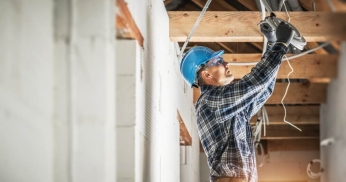 Home Insurance
Home InsuranceHow to get insurance for your fixer upper
Despite a decrease in interest rates over the last couple of years, Canada still has one of the most expensive real esta...

Compare the lowest comprehensive home insurance quotes and save over 20%*.
Get 50+ quotes in 3 minutes.
Compare rates from Canada's leading comprehensive home insurance providers

have compared rates and saved money over the last 24 hours
Comprehensive (also called ‘all risk’) home insurance coverage covers your property and belongings from all loss, except some exclusions, which should be listed on your policy. It also provides coverage for your property’s secondary structures, such as a detached garage, guest house and so forth.
Out of the three major home insurance coverages, which include standard (or named perils) and broad form, comprehensive coverage offers the greatest level of protection – and is therefore the most expensive one. So, while it grants homeowners peace of mind, it may not be the best option for everyone. There are several factors to weigh when choosing the right kind of home insurance.
A comprehensive home insurance policy will protect your home from all risks (except named exclusions), covering the costs of:
Rebuilding your home in case of damage (extended dwelling coverage)
Replacing personal contents damaged by a covered event
Covering any injuries and damages that happen on your property (liability)
Reimbursing living expenses that may occur due to damages (hotel and food)
Flood, earthquake or sewer back-up are some of the optional coverages that you may be able to purchase separately.
A standard home insurance policy provides coverage for your home but does not include extended dwelling coverage, additional living expenses coverage or contents protection.
A broad form home insurance policy provides mid-tier home insurance coverage, which is more than a standard policy but less than a comprehensive policy. As such, it is priced accordingly. Most often, a broad form home insurance policy includes coverage for the home itself, some contents and other structures on your property. Standard coverage is the least expensive and only provides coverage for perils specifically listed on your home insurance policy.
Comprehensive policies typically include greater coverage for both liability and contents. They also offer additional forms of medical and living expenses coverage.
| Protection | Standard | Broad form | Comprehensive |
|---|---|---|---|
| Main dwelling | Covered | Covered | Covered |
| Additional buildings | Dwelling itself | Covered | Covered |
| Contents | Only named perils | Only named perils | Covered |
| Additional living expenses | Not covered | Covered | Covered |
| Personal liability | Optional | Covered | Covered |
| Voluntary medical payments | Optional | Covered | Covered |
Within comprehensive coverage, there are usually two areas of risk that are excluded, such as:
Uninsurable risks
Any damage that is preventable with proper home maintenance is not covered by a comprehensive home insurance policy and is known as an uninsurable risk or exclusion.
For example, if your roof is already damaged and isn’t maintained properly, or you get an infestation of rodents due to lack of maintenance or cleaning, further damage won’t be covered under your policy. Here are the most common examples of uninsurable risks:
Wear-and-tear
Animal or insect damage
Pollution
Anything covered by other insurance, such as your car
Large-scale natural disasters, such as flooding
Intentional losses
Mold
Additional coverage
Add-ons or endorsements allow you to add coverage to your policy. The most common home insurance add-ons, which aren’t usually included as part of a comprehensive policy are:
Overland water
Earthquake damage
There is no one-size-fits-all insurance policy. To decide which one is for you and your circumstances, you’ll first need to ask yourself a few questions.
Does your home have additional structures, such as a detached garage, swimming pool or gazebo? If so, comprehensive coverage will allow you to cover your entire property, including any attached/detached structures from all risks (minus policy exclusions). If your home doesn’t have a complex design with additional structures, a standard home insurance policy may be a better option, as you’ll save money on your premium.
Can you afford to cover additional expenses if a disaster strikes, and you’re temporarily displaced? A comprehensive plan covers additional living expenses when such situations occur. This coverage usually includes accommodation and food costs. It is part of a comprehensive policy and can be added as an add-on to lesser coverage. Talk to your insurance provider for more information.
If an accident occurs on your property, can you cover the liability costs? Additional liability protection covers potential lawsuits, personal injuries and so on. If you own pets, especially dogs, we advise getting liability coverage – in case they attack a visitor.
Do you own valuable objects? If you have possessions like expensive jewelry or rare art, a standard or broad form home insurance policy may not be enough to cover you. Some comprehensive policies may even include mysterious disappearance coverage – in case you lose that expensive diamond ring, or if a valuable object goes missing after a house party, for instance.
Your choice of home insurance coverage will depend on your needs. The example scenarios above should give you a sense of whether comprehensive coverage is necessary for you. Of course, these scenarios tell only a partial story, and discussing your needs with your insurance provider is the best way to ensure you get the right coverage.
First, we need to know about you and your home. It only takes 3 minutes, and it’s 100% confidential.
Next, we’ll show you quotes from 50+ Canadian providers. It’s free, with no commitment.
When you find the best quote, secure your comprehensive home insurance rate by talking to a licensed broker or agent.
Finding the cheapest comprehensive home insurance in Canada starts with comparison sites like LowestRates.ca. In minutes, you can acquire the cheapest quotes from the top providers in your area. Simply input a bit of information about your home and your insurance needs, and we’ll do the rest.
It’s wise to also talk to insurance professionals to see what kinds of coverage they are willing to offer and at what price. You might even want to ask for a referral from a trusted friend or neighbour.
The replacement cost of your home can change over time. Here are the five factors that help determine it:
New building codes that were set up after your home was built: In the event your home is damaged by a natural disaster or accident, your new building will have to meet the up-to-date building codes to ensure the safety of the dwelling. Insurance companies may offer building code coverage, which means they’ll cover the cost of code requirements. Ask your insurance agent if that’s something available to you.
Remodeled kitchens: Kitchen upgrades can increase the replacement cost of your home. If you have expensive additions, such as quartz or granite countertops, double tub stainless steel sinks or resilient flooring, you’ll have to adjust your insurance policy to match the increased value of your home.
Additional rooms and structures: Any additional rooms add to the overall value and replacement cost of your home. You should always update your home insurance policy to reflect these additions.
Rising cost of building materials and construction: The cost of bricks, cement, timber and stone increases with time. For example, prices may increase if a natural disaster has wrecked your area and affected the overall supply and demand. Construction itself is also expensive, involving the cost of workers’ wages, permits and designs. These factors come into play when setting a replacement value for your home.
Hard-to-replace features/age of home: If your home has rare and hard-to-replace features, such as bronze faucets, intricate ceiling designs, chandeliers and so on, you may need to pay extra to have them replaced. Unique features always add to the overall value of a home, so make sure that your insurer is aware of these features.
Each homeowner is different with different amounts of contents within their home. It’s best to assess the value of your contents to ensure you are getting the right coverage.
If your stuff is not particularly valuable, having lots of content coverage is overkill and that will increase your insurance premium. Make sure the content coverage you have doesn’t vastly exceed the value of the items being protected.
Living in a home and collecting items over time can add to the value of the contents within your home. It’s best to keep a running inventory of everything you own and write down the value of those items. If you can, take photos of all your receipts too. Remember to separate your most expensive items from the rest when making your inventory list and ask your insurer about the best coverage options for particularly valuable possessions.

Joel Kranc
About the Author
Joel Kranc is an award-winning writer, author and journalist. Most of his experience lies within the institutional investment and financial services space. He also covers a variety of business topics for publications in North America and the UK.
 Home Insurance
Home InsuranceDespite a decrease in interest rates over the last couple of years, Canada still has one of the most expensive real esta...
 Renting
RentingThis article has been updated from a previous version. In the rapidly evolving real estate landscape in Ontario,...
*Shoppers in Ontario who obtained a home insurance quote on LowestRates.ca from January to December 2022 saved an average of 20%. The average savings percentage represents the difference between the shoppers’ average lowest quoted premium and the average of the second and third lowest quoted premiums generated by LowestRates.ca. Excludes tenant and condo insurance.